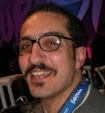When the Going Gets Tough
I saw this interesting article in today's Times of London. I thought I'd blog it so I can read it again later.
Is the world wide web art's final frontier?
by Grayson Perry
Some people, I imagine, still hold on to the quaint idea that there is a cutting edge in contemporary art. They think that in some café or college somewhere they will find a bunch of young revolutionaries forging the next chapter in a chronologically neat story of art. If one were to seek out that mythical avant-garde coterie at the moment, a good place to look might be the world wide web. This awesome information technology that we are rapidly taking for granted is an arena that is apparently attracting artists who want to push the boundaries of what art can be. I thought the boundaries in art had all been crossed in the Sixties, or was it a century ago? Maybe I was wrong.
I had a good opportunity to find out more about this virtual world when a friend came to stay at my dacha. He is Charlie Gere, reader in new-media research at the Institute for Cultural Research at Lancaster University, and has recently published a book called Art, Time and Technology (Berg).
I asked him: “Is new-media art, that is art using computers, robotics and the internet, going to be the next big thing?” Answer: “No.”
The web, Charlie says, has the alarming potential of realising the idea of the artist Joseph Beuys, that everyone is an artist. This could spell the end of art as we know it, when everyone becomes a producer and we all drown in a sea of mediocrity made up of billions of minutely-niched microchannels.
Some people may think it is being creative to use a wacky font in a funny colour on their page on MySpace but the most interesting artists are using computers for more than just mastering Photoshop or writing a blog. Charlie thinks a good example of this is Short Films about Flying, by Jon Thomson and Alison Craighead (www.thomson-craighead.net).
Shown as a gallery video installation, it appears to be a series of short videos. They begin and end with a countdown and titles and we assume that they are conventionally recorded and edited. But the content is actually live and random. Our preconceptions about time are being played with. The shots of aircraft landing and taking off are live from a webcam at Boston airport, remotely controlled by random visitors to a website. The text is plucked at random by the computer from a chatroom and the music is sampled live from a radio station. We so want to believe that there is a controlling consciousness that we read significance into chance encounters of text, music and CCTV.
Charlie thinks new-media art is at a similar stage to video when it was in its infancy. In the early days the equipment was crude and video art was ignored by the establishment. In the Sixties the technology was the headline; now we find nothing remarkable in a black cube containing yet another beautifully displayed video projection. We have to remember that when Nam June Paik and others started, the very fact that they used video was seen as radical, as well as a critique of television itself. Now flat screens and projections have made the technology so discreet and tasteful that even the National Gallery stages a show of Bill Viola.
New-media art has similar traits of technological fetishism and also what Charlie calls “heroic marginality”. Software artists such as Alex McLean (www.yaxu.org) are such hardcore outsiders that their art is in the computer code they write, which is appreciable only by others who can understand that code. Net.artists such as Vuk Cosic (www.ljudmila.org/~vuk/) can be so anti-commodification that they will go to the lengths of sabotaging attempts by organisers of festivals such as Documenta to archive their work by pre-emptively publishing it on the net.
This rebellious stance is understandable when we remember that the whole personal-computer ethos comes out of the West Coast hippie counter-culture. This is still evident in the bohemianism that is allowed to cling to the Apple brand.
What is different from the Sixties is that artists no longer believe in utopian technological progress. Unlike artists such as John Cage and Alan Kaprow who thought they were the future, today’s new-media creatives are questioning and ironic about it.
So are artists at the cutting edge of new-media technology? No, says Charlie. One of the problems is that other stuff on the net is so much more mind-blowing. A site such as Google Earth is so much more awesome and thought-provoking than something an arty hacktivist can knock up on her PC.
Artists such as Susan Collins are trying to find modest meditative ways of humanising the cold stream of zeros and ones. Her piece Fenlandia (www.susan-collins.net/fenlandia) shows us a webcam view of East Anglia that slowly refreshes the frame over 44 hours. She is using the technology set up to send us a real-time image to give us something very old-fashioned — the experience of contemplating a painting.
So if art is not at the cutting edge of new-media technology what is? In terms of innovative delivery systems and use of the web, says Charlie, it’s porn.


















Hello,
Your site is really interesting. I invite you to visit my blog, I hope that you like it.
Greetings,
Post a Comment
<< Home